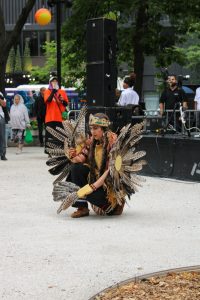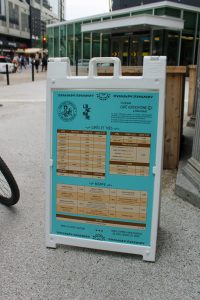In Montreal, you can feel the influence of the next door neighbor: the glass and steel skyscrapers, the wide boulevards and the imposing cars. From Europe, we find a certain architecture and the emblematic sounds of Quebec. This mic-mac leaves little room for Aboriginals who are nevertheless the descendants of the first inhabitants of the country.
Every June 21 for the past few years, its ancestral inhabitants have nevertheless been the center of attention. National Indigenous Peoples Day in Canada concludes a month of pride in which their cultures are honored. Other cities in the country are entitled to their festivals or to their powwow outside. In Montreal, Cabot Square is the place to go.
At the beginning of the afternoon, there were already a hundred of them patiently waiting for the start of the concerts. On the bill: indigenous artists who share the light for a moment with the artists and craftsmen who have come to exhibit their know-how. Soapstone sculpture workshop for the little ones, sale of qulliq -meditation stone- for the spiritual, and concerts for those who enjoy dancing: the day is open to everyone, families, curious, and especially the excluded.
Homelessness: Montreal, place of fall
“Most Aboriginal people are not there by choice but by necessity. They usually came to town out of medical need »indicates an official of the borough of Ville-Marie, the district where the square is located.
Lack of accessibility or intra-family violence, Aboriginal people who come to Montreal find themselves on the street more easily. ” They been through things with their parents, that’s why they landed there confirms Johanne Couture, a Montrealer by birth who discovered her Abenaki roots late in life.
Most Aboriginal people are there not by choice but by necessity.
So Cabot Square becomes for them a new home without a foundation. However, development work and the relocation of a homeless shelter have made the place more and more hostile over the years. In December 2018, an emergency accommodation center located a few steps away moved to the north of the city. The wanderers did not follow. The following year was macabre. 14 people of aboriginal origin lost their lives in a few months inside the square.
The other shelters in the city of Montreal are too few, too far away to offer shelter to everyone. In 2001, 48% of Aboriginal people in Canada lived outside community villages (the official term “reserves” being decried). Far from folklore, the social reality of the First Nations, Inuit and Métis is quite different and the largest community in Quebec is located within the Montreal metropolis. A growing population since in 2020, 35,000 people identified themselves as Indigenous in Montreal, a figure that has jumped 211% in twenty years.
“Demystifying Homelessness”: The Challenges of Indigenous Inclusion
In Montreal, native and non-native citizens look at each other like a dog. The borough official admits that the first objective for the Canadian authorities is to “demystifying homelessness which is often seen as a choice.
By nature, Aboriginal people are nomadic, and they were, moreover, before forced sedentarization. Aboriginal people are said to be idle and have a fondness for the bottle. It doesn’t matter that the consumption of alcohol was imported by the settlers: clichés die hard.
“Sometimes it’s hard to communicate “, concedes the official. In Canada, the majority of Indigenous peoples are English-speaking. In Montreal, the language barrier therefore comes on top of cultural barriers, ignorance and intolerance. As a result, itinerant Aboriginal people distrust non-Aboriginal institutions. Christina, who has been living on the streets for four years, does not like going to city-run shelters very much. ” They don’t like us » (“they don’t like us”), assures the thirties.
” In the French-speaking territories, the authorities began to take into consideration the indigenous populations long after English-speaking Canada », explains Marilou Maisonneuve, the Director of Round House Cafe – a solidarity café run by Indigenous people in Cabot Square and the only Indigenous café in Montreal. ” We are always behind on social issues “, grimaces the young woman with a belly rounded by her pregnancy.
Opened in 2015, the café is managed by an Aboriginal association and overseen by the Ministry of Labour, Employment and Social Solidarity and is aimed primarily at homeless people aged 18 to 30. ” We have two streams. The first part is open to everyone. All you have to do is come in the morning and you hire four employees every day. The cover is offered and the money for the service is distributed each evening in cash. Many homeless people don’t have a bank account. “, she says. ” The second part is for the most diligent or those who want to go further. In addition to work, they are offered employability workshops, for self-development as well as Aboriginal cultural activities.“, specifies the young woman who herself has aboriginal origins. ” Here, we try to promote indigenous culture, not deny it “, she breathes. 45 people have already benefited from these programs.
The coffee menu offers native specialties.
At the Café, it is possible to meet Michelle. The young woman occupies her free time by lending a hand. After the school holidays she will go back to university. He misses his city of Edmonton, in the English-speaking state of Alberta: At my place, we regularly have pow-wows. Of course, there could be more aboriginal culture in Montreal. The contrast is striking “, hallucinates the student.
On this festive day in Cabot Square, families are happy to take pictures of their youngest, drum in hand. In indigenous cultures, the drum is a sacred instrument used during invocations. The teenage girls have dressed up for the occasion, their fingernails painted in the colors of the indigenous peoples: orange, black and white. Celebrations are highlights within Indigenous communities.
The non-natives must recognize all that we have brought to this country.

For Indigenous Peoples Day, some had dressed in traditional costumes.
Montreal is not the only city to act as no man’s land cultural. Héléna Lalo, who represents Aboriginal people “in urban areas” within the Quebec Native Women collective (FAQ) “ dreams of organizing a large gathering in Quebec City – or bring in several different communities to discuss over several days. A single mother, Héléna left her Innu community of Unamen-Shipu 15 years ago, located much further north in the country, to take care of her autistic daughter. As soon as the opportunity arises, “I involve my youngest children in workshops or cooking classes. My 8 year old son has attended healing rituals and he just learned the bannock recipe “(Typical native bread Editor’s note), she explains.
In the cities, the absence of indigenous culture tries to be filled by one of the 119 indigenous friendship centers scattered around the country. ” There should also be more culture and education in school textbooks “, warns Héléna Lalo. ” The non-natives must recognize all that we have brought to this country. It’s the only way to have peace “, she asserts.
In 2018, the city of Montreal created a position to remedy the invisibilization of Indigenous people. Street names, historical sites and accessibility of emergency housing: Marie-Eve Bordeleau has the immense task of reconnecting Montreal with its roots as Commissioner of Indigenous Relations. Especially since the native citizens have no intention of leaving. ” My name is Florence. Or could I go somewhere else ?”, laughs one of them, imitating the French accent.
There are more and more aboriginal people to stick together.
Florence, who belongs to the Cree nation (in the native language “Eeyou”) arrived in Montreal in 1981 and spent several years on the streets. She has not touched drugs for several years. We slip him a ” well done”. ” The situation improves over time “, she cuts us off. She points out: there are more and more aboriginals to stick togethers”.
Initiatives to unite the community
At Cabot Square, it’s a bit like a family that has been formed, not without difficulty. “In 2014, the city undertook work to make the square more user-friendly and more open to the cityexplains Marilou from Café de la Maison Ronde. “An Inuit organization, the Aboriginal Community Network of Montreal, fought for there to be a place for homeless Aboriginal people. They are the ones who thought of converting these old public toilets into a social economy café»she says.
In the same vein, the municipality organizes every summer at the square “Native Fridays” mixing debate and entertainment. Enough to make this place the unique – and all the more precious – vibrant heart of Montreal’s Aboriginal life. ” I often come here because when other homeless people don’t see me for a while, they get worried. And if I don’t see them for a while, I worry observes Christina. ” It is my family“.
Meline Escrihuela, special correspondent in Montreal as part of a trip around the stories of indigenous women organized by the France-Canada association
We want to give thanks to the author of this write-up for this awesome material
In Montreal, wandering and Aboriginal identity – Bondy Blog
Check out our social media accounts and also other related pageshttps://nimblespirit.com/related-pages/

